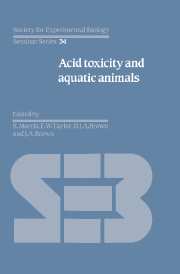Book contents
- Frontmatter
- Contents
- Contributors
- Units, Symbols and Formulae
- Preface
- Introduction: The causes and consequences of surface water acidification
- Invertebrate communities in acid streams
- Fish survival in acid waters
- Field studies on fisheries in acid waters in the UK
- Episodic changes in water quality and their effects on fish
- Acid–base regulation in fishes: 1. Mechanisms
- Acid–base regulation in fishes: 2. Biological responses and limitations
- Intracellular pH regulation and the effects of external acidification
- The physiological problems of fish in acid waters
- Laboratory studies on invertebrate survival and physiology in acid waters
- The physiological problems of crayfish in acid waters
- The effects of hydrogen and aluminium ions on fish gills
- The combined effects of pH and trace metals on fish ionoregulation
- Endocrine responses to acid stress in fish
- Commentary and conclusions
- Index
Commentary and conclusions
Published online by Cambridge University Press: 05 February 2012
- Frontmatter
- Contents
- Contributors
- Units, Symbols and Formulae
- Preface
- Introduction: The causes and consequences of surface water acidification
- Invertebrate communities in acid streams
- Fish survival in acid waters
- Field studies on fisheries in acid waters in the UK
- Episodic changes in water quality and their effects on fish
- Acid–base regulation in fishes: 1. Mechanisms
- Acid–base regulation in fishes: 2. Biological responses and limitations
- Intracellular pH regulation and the effects of external acidification
- The physiological problems of fish in acid waters
- Laboratory studies on invertebrate survival and physiology in acid waters
- The physiological problems of crayfish in acid waters
- The effects of hydrogen and aluminium ions on fish gills
- The combined effects of pH and trace metals on fish ionoregulation
- Endocrine responses to acid stress in fish
- Commentary and conclusions
- Index
Summary
Introduction
‘Acid Rain’ as a scientific and political issue has advanced since early claims of ecological damage were first formulated in the 1950s and 1960s from the initial, rather simplistic, assumptions and interpretations that could be formulated as a sequence of events initiated by the emission of SO2 from fossil fuel combustion, the formation of acidic radicles in the atmosphere which were then removed by rain and deposited; the rain falling in unbuffered waters rendering them acid by progressively consuming their alkalinity.
Following this early conceptualisation, the contributions of N gases and ammonia were later accepted, as well as the complexity of chemical reactions in the atmosphere and the alternate mechanisms of deposition. Hydrological and geological characteristics of catchments were also recognised as major influences determining the quality of surface waters which were thus distinguished from atmospheric deposition. The ‘susceptibility’ of a lake or stream was seen to be dependent not only on the rate of acidic deposition but also on the supply and/or depletion of alkaline materials leached from soil and weathered from rock. Where loss is not matched by supply from leaching and weathering, these materials become depleted in surface waters. It is recognised that this may eventually become intolerable for some aquatic species although others may be able to exploit the resultant loss of competition. Initial concern was expressed for fish, reported as lost from the affected lakes and rivers: other biological components of the aquatic ecosystem are reported to be similarly restricted.
- Type
- Chapter
- Information
- Acid Toxicity and Aquatic Animals , pp. 265 - 276Publisher: Cambridge University PressPrint publication year: 1989
- 1
- Cited by



